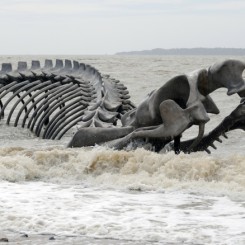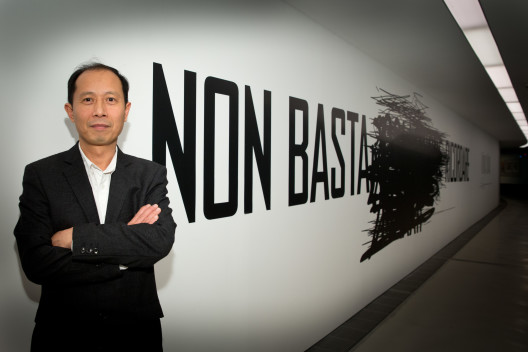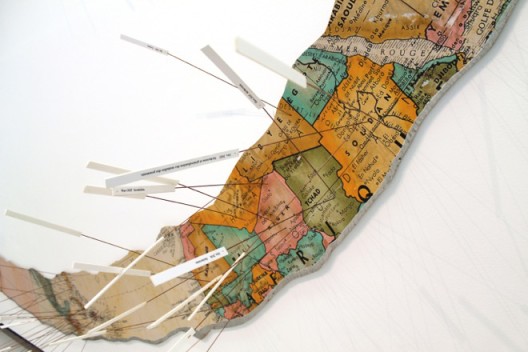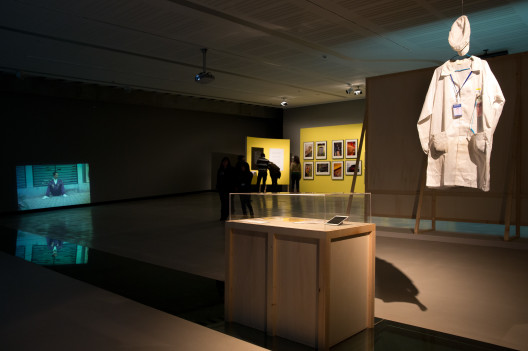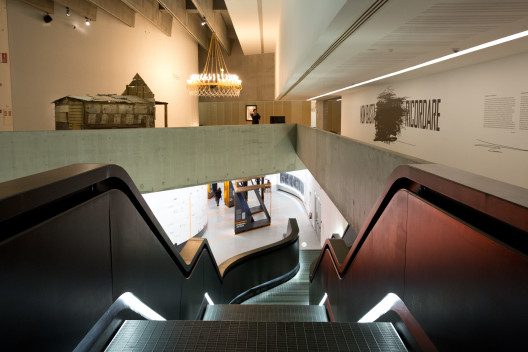One of the key artists to have emerged in the 1980s contemporary art scene in China, Huang Yong Ping (b.1954, Xiamen) was the most prominent member of the Xiamen Dada group, which advocated and practiced an an absurdist and subversive anti-institutionalism, including in 1986 burning their recently exhibited work outside the Cultural Palace of Xiamen. In 1989 Huang visited Paris for the “Magiciens de la terre” exhibition and, in the aftermath of the crackdown in China, has lived there ever since. He represented France at the Venice Biennale in 1999 and has recently taken French citizenship.
Here the art historian, critic and director of MAXXI, Rome, Hou Hanru, spoke with Chris Moore about “Baton Serpent”, a major survey of Huang Yong Ping’s recent work and the artist’s first major exhibition in Italy. Hou Hanru (b. 1963, Guangzhou) has curated bi/triennales (Shanghai, Auckland) and seminal exhibitions of Chinese contemporary art around the world. After leaving China in 1988, Hou lived in Paris for 16 years before moving to San Francisco, where he was Chair of Exhibition and Museum Studies at the San Francisco Art Institute from 2006-2012. In December 2013, Hou was appointed Director of MAXXI, the National Museum of the 21st Century Arts in Rome. Designed by Zaha Hadid, MAXXI opened in 2013 following ten years of construction.
Chris Moore: I’d like to begin with your move to MAAXI. How is it going and how you are introducing your Chinese experience to the institution and to Rome?
Hou Hanru: Everything is going well; I decided to work at MAXXI because I saw an opportunity which is very interesting—it’s a new institution and I really saw that there was a kind of—I would not say “innocence”—but a kind of urgency that we need to build a new institution. It allowed us to focus on things that I think are crucial for our time in terms of what contemporary art can do to society. One of the main foci I have been working on is to introduce another perspective in terms of how contemporary art interacts with the world . . . really to look into how a so-called European cultural capital—a European city and also Europe in general—is trying to define its place in the world today. I would not say it’s particularly related to my Chinese experience, but it’s related maybe to experiences of mine that are shared by other people who have been working in connection with a perspective that is much wider than following a normal trajectory of art history, especially from modernism to the so-called postmodern.
I have lived in a state of almost constant nomadism across the globe for the last two decades. This allows me to look at the world with a more open and ambitious perspective. On the one hand, it allows us to have windows onto different parts of the world, and also to understand the meaning of this so-called “cultural diversity”—this tension between globalization and reactions from all around the world—its impact on social and political changes. On the other, it can also help us to define a new foundation for what we might call artistic creation today and also, maybe in the future, a different way of writing art history.
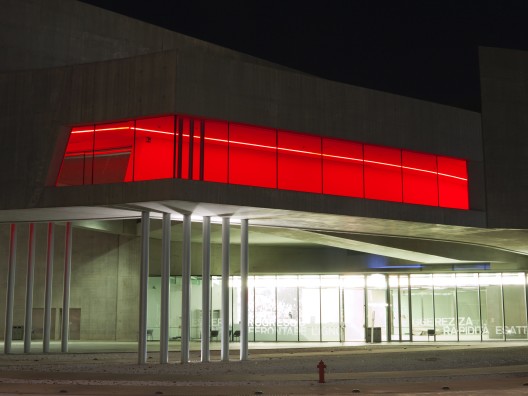
Jean-Baptiste Ganne, “El Ingenioso hidalgo Don Quijote de la Mancha”, installation view, MAXXI, 2014. Courtesy the artist
Jean-Baptiste Ganne, 《机智的贵族堂吉诃德》,展览现场,罗马二十一世纪国立现代美术馆,2014. 图片惠允:艺术家
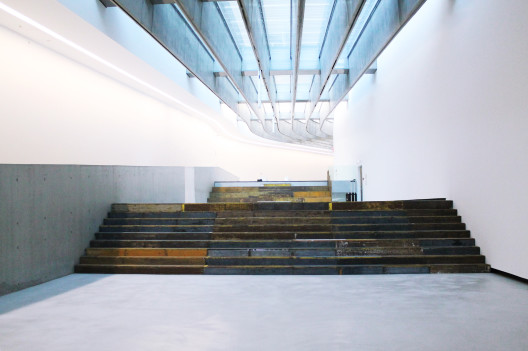
Cevdet Erek, “A Room of Rhythms – Curva”, installation view, MAXXI, 2014. Photo: Giorgia Romiti, courtesy Fondazione MAXXI
Cevdet Erek, 《律动之屋-曲线》,展览现场,罗马二十一世纪国立现代美术馆,2014. 摄影: Giorgia Romiti,图片惠允:罗马二十一世纪国立现代美术馆基金会
CM: So how does Huang Yong Ping fit into this?
HH: The work of Huang Yong Ping is really one of the most important examples of how an artist and also how art in general operates in this context today. His ideas really challenge the ontology of the relationship between what we usually separate as the West and the East, the past and the future.
CM: Well, he is a good example of that himself. He was the key figure in the Xiamen Dada group, and then made the decision—which was quite an early decision, following the “Magicians de la Terre” exhibition in Paris in 1989 (and no doubt motivated by the crackdown)—to move to Paris and make France his home. And so at an early stage of the emergent Chinese contemporary art movement, one of its key figures became part of the diaspora.
HH: Yes, I agree. I think his move to France was not only circumstantial. Actually, he didn’t really choose to move to France. It was because of things happening [in China] in the spring of 1989—like all of us, we all accepted to live with this destiny. But on the other hand, this destiny has been very much inscribed in the genes, in the DNA of his work, and also maybe the generation of Chinese artists or Chinese intellectuals in general when we discovered the world in the ’80s. We have this strong desire to go beyond national cultural constraints, political constraints, and especially the mindset of geographical self-limitation. I would say we share something really important.
One of the reasons why Yong Ping was so interested in Dada was because, fundamentally, his being an artist in that context was about rebellion against any kind of established ideas, and including what China would be, and also what “the West” means. This is why I think the whole of his life has involved negotiating between these limitations—trying to continue to provoke other ways of thinking about what a definition of culture would be, especially when this definition becomes a discourse on the power system and a kind of institutionalized system. Then, once arriving at a new proposal, he would just escape from there and do something else. This is why his work really involves constant change, negotiating—navigating—through many different cultural resources that are not only Chinese, and not only Western. He was also digging into Islam and looking into Buddhism, and more recently into, I don’t know, medieval European ideas; he also looking at Indian, Mayan . . . [ideas]
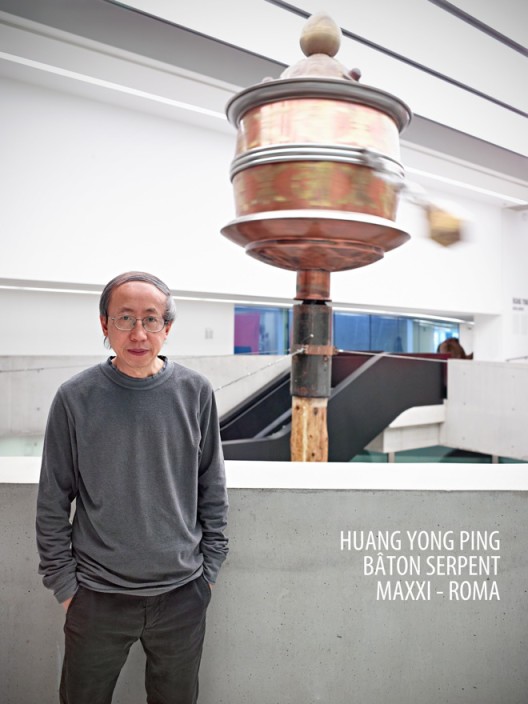
CM: One of the things that struck me about the recent works by Huang with the animals, is that there are at least a couple of other key Chinese artists who have also—in totally different ways, but nevertheless—used metaphors of animals in their art as a medium, particularly Cai Guo Qiang and Yang Jiechang, and this idea of a menagerie, of a zoo.
HH: Yes, but I think it’s completely different.
CM: Exactly.
HH: Huang Yong Ping started with the images and the idea about animals a long time ago, long before others in the “Chinese contemporary” camp. I remember that a couple of the first works where he was using animals were in 1992 and 1993, conceived and realised in the UK—one is “Passage”, which we worked on together in Glasgow, where he exhibited a cage containing the remains of animal bones eaten by a lion and the excrement it left. It was actually questioning the relationship between the colonial or exotic reading of the other and control over the other: he found a half body of a lion collected by the colonizers from Africa displayed in the History Museum in Glasgow, and was inspired by the complex implications of such a representation. Then, he decided to try to bring a lion from the zoo to put in the gallery as a controller of the border. In the end we couldn’t have the lion in the gallery but we collected evidence—shit and the blood and the bones eaten by the lion—to put in the cage and to be the guardian of the entrance of the gallery (you know, like at the airport where there are barriers separating UK nationals and other origins, right?)
CM: (Laughing) Yes!
HH: So that was the beginning. Another piece was called “Yellow Peril” and was exhibited at the Museum of Modern Art in Oxford. He introduced locusts, the insects famous for destroying crops—in Chinese they are called “huangchong” (蝗虫), or “yellow insects.”
CM: I know what you mean; it was actually used by a former German government minister to describe private equity investors—locusts!
HH: Yes, exactly. In the Chinese connotation, this insect is very clearly about the degradation of the other. For example, it’s an image that one can associate with the caricatured image of the Chinese during the anti-Chinese periods in Europe and the US. Recently, in Hong Kong, when the Hong Kong people talk about the Mainland Chinese coming to shop in Hong Kong and kind of upsetting the public infrastructure, they called them locusts as well. This is a way to express the frustration of the local population facing the “Mainlandization” of the former British colony and its singular mode of life.
So it’s kind of a colonial metaphor for the invasion of the Chinese. Yong Ping put the insects at the entrance of the Oxford museum, and every visitor had to go underneath them. Actually, it spoke also to the struggle between cultures. In the 19th century, many Europeans were saying the Chinese should be extinguished from the earth because we represent disaster, and so on. So Yong Ping put the insects together with scorpions—they represent Western power. That was a very literal struggle in the work—a war between these two creatures.
Later, he explored the metaphor of insects, and also traditional Chinese ways of thinking, much more deeply. There are different kinds of legends in China—when the insects come together, they have different functions. Some relate to black magic—such as regarding the survivor of hundreds of different kinds of insects fighting and eating each other. In the end, the survivors become the real kings of nature. That was a part of the black magic thing—the magician used these “kings” as a way to heal all kinds of diseases.
Then Yong Ping wanted to really understand the usage of what we consider a dangerous animal or something that should be excluded from civilization. All in all, this shows one really important thing: his way of understanding animals is much related to what Foucault developed in his archaeology of knowledge, which was continuously to challenge all kinds of established definitions of natural things, and their usage, and how this is turned into the power of the institution.
CM: The ranking and categorization of species.
HH: I think Yong Ping’s use of animals is therefore much, much deeper and much more intellectually and politically challenging than that of other artists.
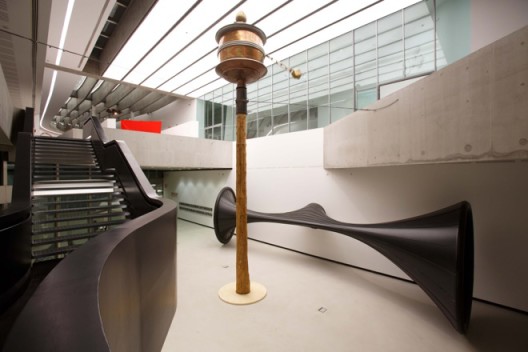
Huang Yong Ping, “Ehi Ehi Sina Sina”, (installation detail), Panthéon, International Centre for Art and Landscape – Vassivière Island, 2006. Photo: André Morin. © Huang Yong Ping. Courtesy of the artist and Galerie Kamel Mennour, Paris
黄永砅, 《Ehi Ehi Sina Sina》(现场局部),万神殿,瓦斯维埃尔岛国际艺术景观中心,2006。摄影:André Morin。版权归属:黄永砅。 图片惠允:艺术家,巴黎 Kamel Mennour画廊
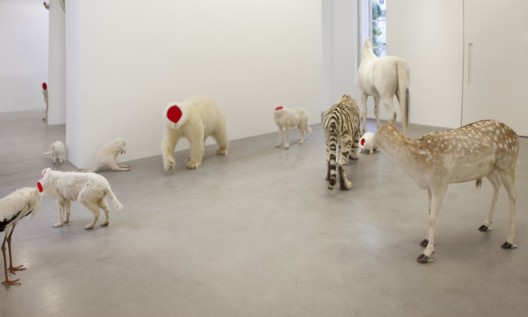
Huang Yong Ping, “Bugarach”, (installation view), fiberglass, concrete, stuffed animals, model helicopter, siren, porcelain, dimensions variable, 2012. Courtesy of the artist and Galerie Kamel Mennour, Paris
黄永砅,《比加拉什》(展览现场),玻璃钢,混凝土,动物标本,模型直升飞机,警笛,陶瓷,尺寸可变,2012。图片惠允:艺术家,巴黎 Kamel Mennour画廊
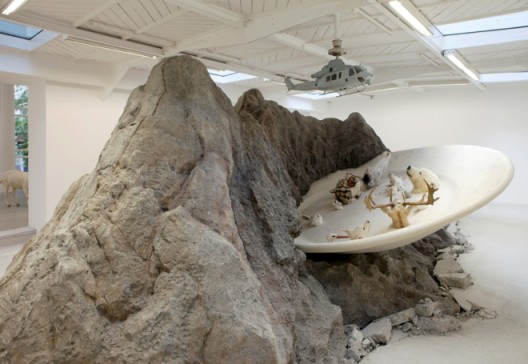
Huang Yong Ping, “Bugarach” (installation view), fiberglass, concrete, stuffed animals, model helicopter, siren, porcelain, dimensions variable, 2012. Courtesy of the artist and Galerie Kamel Mennour, Paris
黄永砅,《比加拉什》(展览现场),玻璃钢,混凝土,动物标本,模型直升飞机,警笛,陶瓷,尺寸可变,2012。图片惠允:艺术家,巴黎 Kamel Mennour画廊
CM: Yes—well, they are all decapitated! They are just walking round the stage, decapitated . . .
HH: This idea came from (laughs)—this is also very interesting—a work he developed inspired by Mao’s train; it was a kind of a reproduction of Mao’s epic train. Mao travelled around the country in his train, trying to escape from any kind of fixed location, to exercise his power. Thus many major political decisions in China from the ’50s to the ’70s came about on that train; for Yong Ping, this train is like a moving master—a machine producing all kinds of outcomes, for better and for worse. And then he understood that this train is really complying with the image of the master, the leader, the boss, the head—like a kind of Leviathan. This is why he put the huge fish head on the front of the train. And on this head, he grafted different, parasitic animal heads.
CM: Parasites? I always thought of it a little bit like an ark, where all the animals are rescued.
HH: Another story—an ark is of course another story—the ark was not beheaded heads. This parasite idea actually comes from the fact that he actually used a very literal interpretation of “power heads”. On this train, you have the big head which is Mao, and then you have the small heads of all kinds of ministers.
CM: I see! So he’s the fish!
HH: Then, when you look at the work it’s like a huge fish head with other different animals, right? And then there are leftovers of the bodies—what can you do with them? So because of that, he decided to develop a whole system about using these beheaded animal bodies; he questions the notion, according to Western humanist ideas about the harmony of humanity, that the body represents emotion—the heart; and the head represents reason—the mind. They should not be separated. If the head and the body are separated, are we going to become crazy? By separating them, how can we define who we are? Every time he touches on one image, idea or symbol, he seems able to develop a whole line of research around the evolution of this idea and in contradictory, paradoxical directions. There is not one single truth. There is only scepticism. Then, he introduces different cultural resources to interpret and further complicate things in order to demonstrate that paradox is the real essence of existence. For example, in some cases it’s related to coexistence of different religions, or in others it’s about how animals represent an object of projection symbolizing how humans are looking at each other.
CM: Well, it’s a very confusing image because these animals are no threat to one another because they have no teeth; they cannot see each other or smell each other because they have no eyes, no noses . . . They co-exist, but as a number of islands that don’t interact.
HH: It could also be interpreted that way. It really depends on the whole structure. I think in being an artist, one of the key things is not to say exactly what it means.
CM: Yes.
HH: This is very important. I don’t think Yong Ping is the type of artist who tries to elucidate an image. I think the whole of his work is about resisting being interpreted in a literal way.
CM: Quite.
HH: This also makes it very difficult for the curators, the art critics, the media and institutions to handle his work. This is the power his work exerts on us.
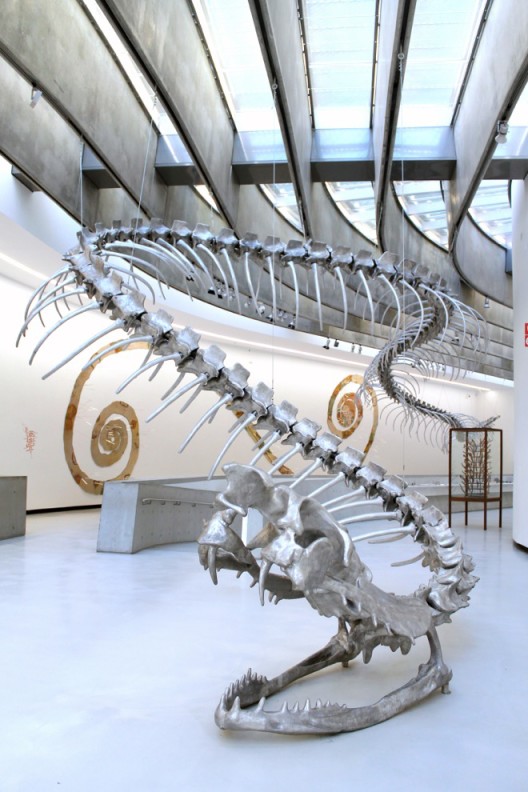
Huang Yng Ping, “Baton de Serpent”, (installation view), aluminium, stainless steel, dimensions variable (length: 53 meters). Courtesy of the artist and the Red Brick Art Museum, Beijing
黄永砅,《巴蛇》(现场局部),铝,不锈钢,尺寸可变(长53米)。图片惠允:艺术家与北京红砖美术馆
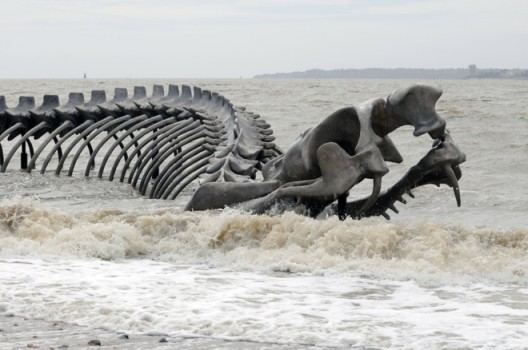
Huang Yong Ping, “Serpent”, installation view at Saint-Brevin-les-Pins (France), 2012
黄永砅,《蛇》,法国 Saint-Brevin-les-Pins展览现场,2012
CM: There are two other works I want to discuss in particular. One I am familiar with, having seen it at the Queensland art gallery—the serpent itself (“Ressort”, 2012). The second is this new version made for MAXXI, “Bâton Serpent”—which is something quite different.
HH: Yes, very different. Of course, he has been exploring the image of the serpent for many years. I remember one of the first was a piece he did in the early 2000s in Germany, which was in a park. And then another major moment was “Serpent d’Océan”, which he created for Nantes in France—on the beach, where the snake came up from the ocean. It was about 180 meters long. It was like a sea snake emerging from the ocean, shedding its skin and appearing as a huge skeleton . . .
He has been very interested in the idea of the snake as a part of the animal world that represents evil and vice . . . it can also represent supernatural or magical powers.
CM: Also, the fact that it sheds its skin—because he also made a work with the elephant shedding its skin (“L’ombre Blanche”, 2009).
HH: Exactly! It’s a process of metamorphosis.
CM: Like a rebirth.
HH: In 1993, in a work for the Wexner Center in Columbus, Ohio, he explored the story of illegal Chinese immigrants jumping from the boat to land in America. There is an expression “renshe” (人蛇), a “human-snake” or “human-serpent”. This is used as a nickname for illegal immigrants; the traffickers are called “shetou” (蛇头), or “snakeheads”. This was a popular expression, especially in Fujian where Huang Yong Ping comes from. He used this image of humans becoming snakes to “invade” or immigrate to other parts of the world and turn it into a key element in his vocabulary, continuously evolving. It has naturally become a more universal symbol of exodus or human migration driven by different economic, social and geopolitical urgencies.
CM: Yes . . .
HH: The piece he created for Nantes was not only a snake coming in to land from the ocean, but also has a strong connotation of geopolitical migration. But the fact that it comes, ends up shedding its skin and flesh, leaving only the skeleton—it’s like a dying body found on the beach. Yet in the meantime, it still has an incredible power of transformation and renaissance. There’s an incredible potential for it to gain new power . . . This time, at MAXXI, it was related to the question of religion. The whole project developed for MAXXI reflected upon different interpretations of religious ideas—from a Tibetan prayer wheel to an Islamic minaret, to the apocalypse images according to Mayan mythology, and so on. There was also one story relating to Moses. When Moses was leading his people to escape from Egypt into Israel, in the middle of the desert when everyone was desperate, he encountered God, who told Moses to put his staff on the earth; when Moses put his staff in the desert, it became a snake. This miracle consolidated Moses’ conviction in the most acute moment of despair. This was the magical moment of transformation—it’s like a miracle, an enlightening moment. Yong Ping used this idea of the skeleton again—not a living snake; but, in transforming a walking stick into a serpent skeleton, it represents potential coming out of ruin. His work always exists in in-between situations; it’s always potentially changing. For MAXXI, he used the same structure that he used for this piece in Germany earlier this year. He added a tail (which is the staff) and unfurled a serpent across the space. It is not a simple serpent. It is also a living body in transformation: a real miracle.
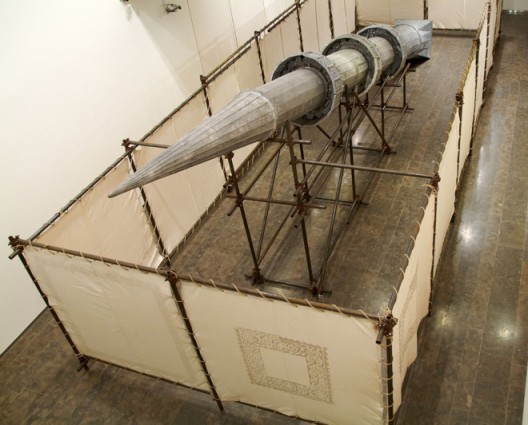
Huang Yong Ping, “Construction Site”, (installation view), 10th International Istanbul Biennale, Istanbul, 2007. Photo: DR. © Huang Yong Ping. Courtesy of the artist and Galerie Kamel Mennour, Paris
黄永砅, 《建筑工地》(现场局部),第十届伊斯坦布尔双年展,2007年伊斯坦布尔。摄影:DR。版权归属:黄永砅。 图片惠允:艺术家,巴黎 Kamel Mennour画廊



